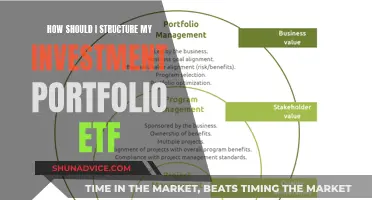
A 401(k) is a retirement account that a company may offer to its employees. It's important to make investment decisions based on both your short-term financial situation and your long-term investment horizon. For example, if you've noticed that your account isn't growing at the rate you'd like and you still have a long investment horizon, you may want to increase the percentage of your savings. On the other hand, if retirement is approaching, you may want to scale back to a more conservative account balance to protect your nest egg.
| Characteristics | Values |
|---|---|
| How often can you change your 401(k) contributions? | It depends on your plan. Changes can be made at any time, but some plans may only allow changes quarterly. |
| How do you change your contributions? | Contact your 401(k) provider, decide how much of your paycheck you want to contribute, taking your company's match into consideration, and fill out any necessary forms. |
| What are some reasons to change your contribution amount? | You may have gotten a raise, experienced a change in your financial circumstances, or wish to increase the percentage of your savings. |
| What is rebalancing? | The act of buying and selling different types of investments so that they align with the percentages in your desired asset allocation. |
| How do you rebalance? | You can sell a portion of the investments that have outgrown their percentage and buy more of the ones that are lagging. Alternatively, you can change future allocations instead. |
| How often should you rebalance? | How often you should rebalance your 401(k) depends on how quickly and how dramatically it has deviated from your desired asset allocation. You may want to check on your 401(k)'s actual asset allocation every year or so and rebalance if necessary. |
| What is asset allocation? | Your asset allocation is the percentage of your money that you want to invest in each particular asset category. For example, you might want to allocate 70% of your portfolio to stock investments and 30% to bond investments. |
| How does age affect your asset allocation? | Younger investors will choose a greater percent of stock funds and a lesser amount of bond funds, while older investors generally hold fewer stock investments and more dollars in bond funds. |
What You'll Learn

Understand the risk of not investing your retirement savings
While it is not always a good idea to invest in your 401(k), there are risks to not investing your retirement savings. If you don't have access to a 401(k) plan, it's important to start saving as early as possible in other tax-advantaged accounts. A 401(k) is a powerful tool to fuel your retirement savings efforts, and while it's not the end of the world if you don't have one, you will need to take action to ensure you have enough money to retire.
The main risk of not investing your retirement savings is that you will not have enough money to live on when you retire. The cost of living continues to increase, and many people underestimate how much money they will need to maintain their standard of living in retirement. By investing your retirement savings, you can take advantage of compound interest and grow your savings over time.
Another risk of not investing your retirement savings is that you may have to delay your retirement. If you haven't saved enough, you may need to work longer to make up the shortfall. This can be difficult if you are no longer able to work due to health or other issues.
Not investing your retirement savings can also impact your quality of life in retirement. You may not have enough money to cover your basic expenses, let alone any leisure activities or travel. This can lead to a very boring and unfulfilling retirement, which is not how most people want to spend their golden years.
Finally, not investing your retirement savings can impact your family. If you don't have enough money to support yourself, you may become a financial burden on your children or other family members. This can cause stress and tension in your relationships and may even lead to resentment.
It's important to carefully consider your financial goals and risk tolerance when deciding whether or not to invest your retirement savings. While there are risks to investing, there are also risks to not investing. It's crucial to weigh both sides before making a decision.
Investing Wisely: India's Salary Allocation Strategies
You may want to see also

Know how much risk you're comfortable with
When it comes to your 401(k), it's important to understand how much risk you're comfortable with. All investments carry some level of risk, and the key is to balance that risk with the potential for rewards. Here are some factors to consider when determining your risk tolerance:
Time Horizon
The time you have until retirement is a crucial factor in assessing your risk tolerance. If you're decades away from retiring, you generally have more flexibility to take on higher-risk investments, as you have time to ride out any market fluctuations. On the other hand, if retirement is just around the corner, it's often wise to adopt a more conservative approach to protect your nest egg.
Risk Tolerance and Emotional Factors
Risk tolerance is an individual trait that varies from person to person. Some people are comfortable with higher levels of risk and volatility in their investments, while others prefer a more stable and predictable approach. It's important to be honest with yourself about how much risk you can emotionally handle. If market downturns cause you significant worry, you may want to consider a more conservative approach.
Financial Goals and Needs
Your financial goals and future needs play a significant role in determining your risk tolerance. If you're aiming for an opulent retirement or have substantial financial needs, you may need to take on more risk to achieve those goals. Conversely, if your financial needs are more modest, you may be able to afford a more conservative approach.
Ability to Save
Your savings ability is another factor to consider. If you're able to save a significant portion of your income, you may not need to take on as much risk to reach your retirement goals. On the other hand, if your savings capacity is limited, you might need to be more aggressive with your investments to make up for it.
Diversification
Diversification is a strategy that can help manage risk. By spreading your investments across different asset classes, industries, and market segments, you can reduce the impact of any single investment on your portfolio. Diversification doesn't eliminate risk, but it can help mitigate it.
Age and Circumstances
Your age and life circumstances also play a role in determining your risk tolerance. When you're younger and unmarried, you may be more willing to take on higher-risk investments. However, as you get closer to retirement and have more dependents, your risk tolerance may decrease. It's important to periodically reassess your risk tolerance as your life circumstances change.
Understanding Market Risk
Market risk refers to the possibility of losing some or all of your original investment due to a significant decline in stock and bond prices. This type of risk is inherent in investing, and it's important to be aware of it when deciding how much risk to take on. Diversification and a long-term investment horizon can help mitigate market risk.
Inflation Risk
Another type of risk to consider is inflation risk, which is the possibility that your retirement funds will not keep up with inflation, resulting in reduced purchasing power during retirement. This risk is often overlooked but can be detrimental over the long term. Even conservative investments carry this risk, so it's important to factor it into your decision-making.
In conclusion, understanding your risk tolerance is crucial when making investment changes to your 401(k). By considering factors such as time horizon, emotional comfort, financial goals, ability to save, diversification, age, and the different types of investment risk, you can make more informed decisions about how much risk to take on. Remember, risk and reward are typically linked, so finding the right balance for your personal situation is essential for achieving your retirement goals.
Equity Investment Management: Understanding the Basics
You may want to see also

Diversify your portfolio
Diversifying your portfolio is a crucial step in managing your 401(k) and ensuring it aligns with your financial goals and risk tolerance. Here are some detailed instructions to help you diversify your 401(k) portfolio effectively:
Understand the Basics of Diversification
Diversification is a risk management strategy that involves spreading your investments across various asset classes, sectors, and investment types. By allocating your capital across multiple options, you reduce the risk associated with putting all your eggs in one basket. This strategy helps capture returns from different areas while protecting your portfolio from significant losses if one particular asset class underperforms.
Determine Your Risk Tolerance
Before diversifying your 401(k) portfolio, it's essential to assess your risk tolerance. Ask yourself how comfortable you are with market volatility and potential losses. Generally, younger investors can handle more risk as they have more time to recover from market downturns. As a rule of thumb, subtract your age from 110 or 100 to get the approximate percentage of your portfolio that should be allocated to stocks (riskier) or bonds (less risky).
Allocate Across Asset Classes
Diversify your 401(k) by investing in different asset classes, such as stocks, bonds, cash, and alternative investments. Stocks, also known as equities, are often the riskiest but can offer higher returns over the long term. Bonds are generally less risky and provide more stable returns. Cash investments, like money market funds, are very low-risk but usually offer lower returns. Additionally, consider alternative investments like real estate, precious metals, or commodities to further diversify your portfolio.
Utilize Target Date Funds
Target date funds are a great option for hands-off investors. These funds automatically adjust their asset allocation based on your targeted retirement year. They become more conservative as you approach retirement, reducing your exposure to stocks and increasing your bond holdings. This helps to reduce risk as you near retirement age.
Spread Your Investments Across Different Sectors
Within the stock portion of your portfolio, further diversification can be achieved by investing in various sectors and industries. Consider allocating a percentage of your equity holdings to large-cap stocks, small-cap stocks, international stocks, emerging markets, and alternative sectors like natural resources or real estate. This ensures that your portfolio isn't overly dependent on the performance of a single industry or market.
Monitor and Rebalance Your Portfolio
Diversification isn't a one-time event; it's an ongoing process. Regularly monitor your portfolio's performance and adjust your allocations as necessary. Over time, certain investments may outperform others, causing your desired allocation to get out of balance. By periodically rebalancing, you can sell a portion of the investments that have grown and use the proceeds to buy more of the underperforming assets, thus returning your portfolio to its intended allocation.
Avoid High-Fee Investments
When selecting investments within your 401(k), be mindful of expense ratios and management fees. These fees can eat into your investment returns over time. Opt for low-cost options like index funds, which track a stock market index and typically have lower fees than actively managed mutual funds.
Remember, diversification is a long-term strategy, and it's important to make adjustments as your financial situation, risk tolerance, and retirement goals evolve.
Investing Wisely: Earning $10K Annually with Smart Strategies
You may want to see also

Choose a target date fund
A target date fund is a type of investment designed with a specific retirement year in mind. These funds can hold a mix of assets, typically stocks, bonds, and sometimes cash equivalents. The asset allocation—or the percentage of each asset class—is designed to become more conservative (i.e., less risky) as you approach your target retirement date.
When investors select a target date fund, they are instructed to choose the fund with a target date closest to their expected retirement year. For example, if you plan to retire in 2050, you might choose a "Target Date 2050 Fund." Generally, funds with a longer time horizon have a more aggressive allocation (i.e., a higher percentage of stocks) and become more conservative (i.e., a higher percentage of bonds) as the target date approaches.
- Automatic rebalancing: The fund manager seeks to rebalance the asset allocation over time. As you get closer to retirement, the fund is intended to become more conservative, reducing your exposure to potentially volatile stocks and increasing your holdings in more conservative bonds.
- Diversification: By holding a mix of assets, target date funds help offer built-in diversification, a key principle of investing. This helps spread your risk and potentially smooth out market fluctuations.
- Convenience: Target date funds offer an "all-in-one" approach. You choose a fund with a target date close to your planned retirement year, and the fund manager takes care of the rebalancing.
Target date funds may be a good option for many 401(k) participants, especially those who are new to investing, don't have the time or expertise to actively manage their investments, or have a long time horizon until retirement. However, they may not be ideal for everyone. Here are some things to keep in mind:
- Risk tolerance: If you have a high-risk tolerance, you might prefer a more aggressive asset allocation than the one selected based on your anticipated retirement year alone.
- Investment goals: If you have specific retirement goals or investment preferences, target date funds may not offer the level of customization you desire.
- Fees: Some target date funds may be more expensive than building your own portfolio. Compare the expense ratios of different target date funds offered in your 401(k) plan; generally, lower expense ratios mean that you can keep more of your returns.
- Target date: Choose a fund with a target date closest to your planned retirement year.
- Asset allocation: Understand the fund's underlying asset allocation to get a sense of the risk profile. Generally, younger investors may want to consider a higher allocation to stocks, while older investors may want to consider allocation to bonds. However, all investors should consider their personal circumstances and risk profiles before deciding on an allocation.
- Underlying investments: Some target date funds invest in actively managed funds, while others use passively managed index funds. Actively managed funds typically have higher fees. Some target date funds combine a mix of both actively and passively managed funds.
- Expenses: Compare the expense ratios of different target date funds; a lower expense ratio generally means that you can keep more of your returns.
Preference Shares in India: A Guide to Investing
You may want to see also

Decide on your 401(k) investments
When deciding on your 401(k) investments, it's important to consider your risk tolerance and financial goals. As a general rule, if you have a long investment horizon, it's advisable to be more aggressive with your investments, favouring riskier but potentially higher-return assets like stocks. On the other hand, if you're nearing retirement, it's often recommended to scale back and adopt a more conservative strategy to protect your savings. This shift in investment strategy as you get older is known as rebalancing.
The specific investments available to you will depend on your 401(k) plan, but they typically include a range of mutual funds or index funds, including target-date funds that are tailored to your retirement timeline. You can also diversify your portfolio by investing in various types of financial assets, such as stock and bond mutual funds, to protect yourself from drastic swings in investment value.
When deciding on your 401(k) investments, consider the fees associated with each option. Expense ratios are the fees charged by investments, and they can vary significantly. Generally, you should opt for lower-cost options, such as index funds, which track an index like the S&P 500 and are less expensive than actively managed mutual funds. Even small differences in expense ratios can have a significant impact on your returns over time.
Additionally, it's worth noting that your 401(k) plan may offer a limited number of investment options compared to other types of accounts, such as IRAs, which typically provide access to a wider range of asset classes. If you're unsure about how to allocate your investments, consider seeking advice from a financial professional or using a robo-advisor service.
Tech Innovations: Revolutionizing the Investment Management Game
You may want to see also
Frequently asked questions
You may be able to make changes at any time, depending on your plan. It's important to keep an eye on your account and your investments to make sure that you're saving and investing according to your goals.
You can change your 401(k) investments by adjusting the weight of different asset classes in your portfolio, a practice known as rebalancing. You can also change your investments without rebalancing by buying and selling assets to shift which organisations or commodities you're investing in.
You may want to change your 401(k) investments if you have a long investment horizon and want to be more aggressive to increase your potential for higher returns. On the other hand, if you're approaching retirement, you may want to be more conservative to protect your nest egg. Other reasons include a change in your financial circumstances or salary, or if your original asset allocation has become skewed as certain investments have outperformed others.







